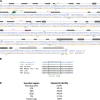Human antibody responses after dengue virus infection are highly cross-reactive to Zika virus
- PMID: 27354515
- PMCID: PMC4948328
- DOI: 10.1073/pnas.1607931113
Human antibody responses after dengue virus infection are highly cross-reactive to Zika virus
Abstract
Zika virus (ZIKV) is an emerging mosquito-borne flavivirus of significant public health concern. ZIKV shares a high degree of sequence and structural homology compared with other flaviviruses, including dengue virus (DENV), resulting in immunological cross-reactivity. Improving our current understanding of the extent and characteristics of this immunological cross-reactivity is important, as ZIKV is presently circulating in areas that are highly endemic for dengue. To assess the magnitude and functional quality of cross-reactive immune responses between these closely related viruses, we tested acute and convalescent sera from nine Thai patients with PCR-confirmed DENV infection against ZIKV. All of the sera tested were cross-reactive with ZIKV, both in binding and in neutralization. To deconstruct the observed serum cross-reactivity in depth, we also characterized a panel of DENV-specific plasmablast-derived monoclonal antibodies (mAbs) for activity against ZIKV. Nearly half of the 47 DENV-reactive mAbs studied bound to both whole ZIKV virion and ZIKV lysate, of which a subset also neutralized ZIKV. In addition, both sera and mAbs from the dengue-infected patients enhanced ZIKV infection of Fc gamma receptor (FcγR)-bearing cells in vitro. Taken together, these findings suggest that preexisting immunity to DENV may impact protective immune responses against ZIKV. In addition, the extensive cross-reactivity may have implications for ZIKV virulence and disease severity in DENV-experienced populations.
Keywords: B-cell responses; Zika virus; antibodies; cross-reactivity.
Conflict of interest statement
The authors declare no conflict of interest.
Figures






Comment in
-
Immunogenic cross-talk between dengue and Zika viruses.Nat Immunol. 2016 Aug 19;17(9):1010-2. doi: 10.1038/ni.3539. Nat Immunol. 2016. PMID: 27540984 No abstract available.
References
-
- Dick GW, Kitchen SF, Haddow AJ. Zika virus. I. Isolations and serological specificity. Trans R Soc Trop Med Hyg. 1952;46(5):509–520. - PubMed
-
- Duffy MR, et al. Zika virus outbreak on Yap Island, Federated States of Micronesia. N Engl J Med. 2009;360(24):2536–2543. - PubMed
-
- Ioos S, et al. Current Zika virus epidemiology and recent epidemics. Med Mal Infect. 2014;44(7):302–307. - PubMed
Publication types
MeSH terms
Substances
Grants and funding
LinkOut - more resources
Full Text Sources
Other Literature Sources
Medical

